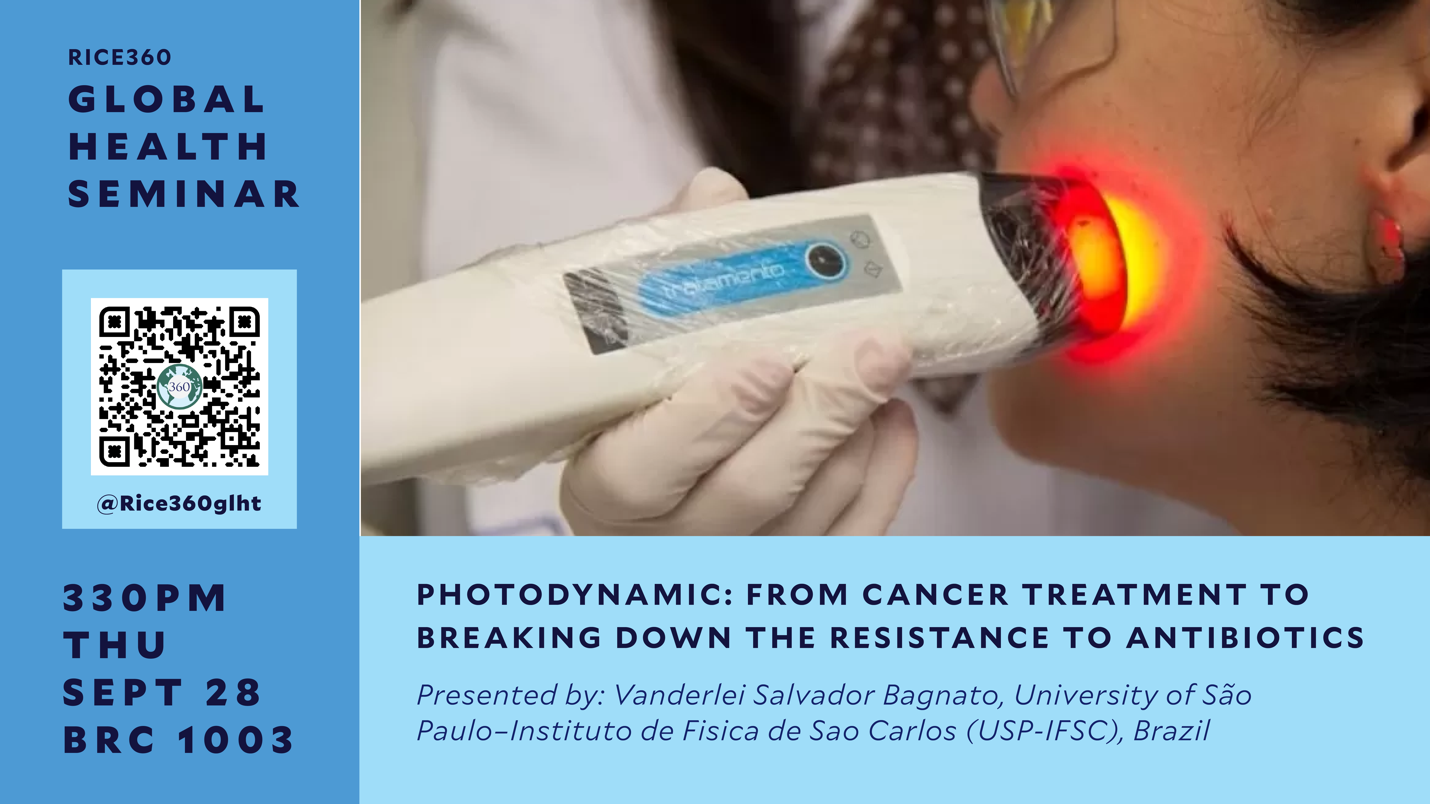Dr. Vanderlei Salvador Bagnato, professor of biomedical engineering at Texas A&M and the University of São Paulo – Institute de Fisica de São Carlos, Brazil, spoke at the Rice360 Institute for Global Health Technologies Rice University on September 28, 2023. He discussed his research in the fields of optics, atomic and molecular physics with cold atoms, biophotonics, and photodynamic therapies (PDT).
Click the video below to watch the recorded seminar.
Photodynamic: from cancer treatment to breaking down the resistance to antibiotics
Bagnato’s scientific contributions include the use of PDT for the treatment of cancer and to address antibiotic resistance. He is a developer and leader of biomedical optics research programs, including 28 research labs in Brazil and Texas. His group implemented the first clinical use of photodynamic therapy to treat cancer and microbiological control in Brazil. He has received several national and international awards, is an Optica Fellow, and is a member of the Brazilian Academy of Sciences, The World Academy of Sciences (TWAS), the US National Academy of Science and the Vatican’s Pontifical Academy of Sciences.
Biophotonics for Cancer, Microbiologic Control, and Beyond
Dr. Bagnato discussed applications of photodynamic action for cancer and microbiological control during this presentation, including unique instrumentation for such applications. He said there is promising technology using light being examined, which goes beyond laser treatments.
“Photodynamic therapy uses light and ultrasound to treat cancer and diseases and break down bacterial resistance to antibiotics,” Bagnato said. “For skin cancer, we have successfully treated thousands of people in Brazil using this treatment.”
-Dr. Vanderlei Salvador Bagnato
He noted that there is a wide array of applications for this work. His research into photodynamics has broad applications in microbiological control, cancer treatment, and pain treatment, as well as chronic diseases. His PDT labs are exploring work on solutions related to Fibromyalgia, Parkinson’s Disease, and cirrhosis of the liver. He works on methods of removing fungus from grain supplies beyond chemical means. PDT has shown success in
treating skin cancer, cervical cancer, and oral cancer. He has done some work on bladder cancer; however, he noted surgery has an advantage over PDT with this type of cancer currently.
Photodynamics works by exciting a molecule that is reactive to light, which produces oxygen and then using the reactive oxygen to destroy the molecule, such as cancer cells. He also used ultrasound to manipulate the reactions of molecules—this is called sonochemistry, which can be used to affect tumors. He explained that additionally, there is work on using shockwaves, which is different from ultrasound, to produce beneficial changes at a molecular level and have potential for treating sub-surface cancers, such as breast cancers.
He explained that the physical principles of light need to be understood in order to use light in this way; this is true for sound waves with ultrasound and pressure waves in shockwave research. Cells are different—so the way drugs are taken up, the way light interacts, and the way sound interacts are all part of the questions this research explores—the work bridges physics and biology.
“Good science is science that advances knowledge. Relevant science is science that advances society and solves real problems in the world. Photodynamics is a two-minute conversation, but the application of photodynamics to cancer treatment is more complex. It is an effort to treat a patient and keep them well.”
-Dr. Vanderlei Salvador Bagnato
Bagnato describes his work as reducing cancer to a problem we can work on—reducing it to a scientific problem within our understanding and then applying that knowledge to developing effective treatments that are better for patients. Being able to do photodynamic therapy for cancer without surgery is a good option for patients. Using microneedles to apply florescence during treatment makes PDT a fast and painless treatment, as shown in clinical trials in Brazil. And, he added, the treatment is 95% effective – they are working toward 97% efficiency. With successful PDT, the complications of surgeries can be avoided, which drives interest. The treatment is also much cheaper than surgery.
Bagnato explained that another promising therapeutic application of biophotonics is breaking down bacterial resistance to antibiotics. Currently, only 10 classes of antibiotics exist to treat bacterial infections. As antibiotic resistance rises, bacterial infections become more challenging to treat. He explained that photodynamics can be used to affect ways in which a bacterium resists antibiotics at the cellular level. This process manipulates the bacteria so that an antibiotic that became ineffective becomes viable again. He noted examples of resistant strep, infections related to intubation, and types of pneumonia as areas they are researching.
The body of research related to Bognato’s work continues to grow. To read more about this research through academic publications, click here.

